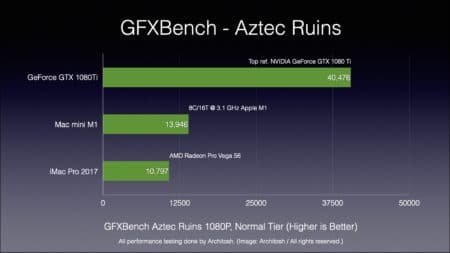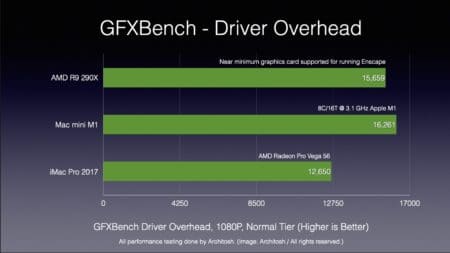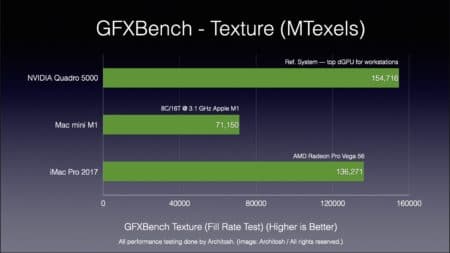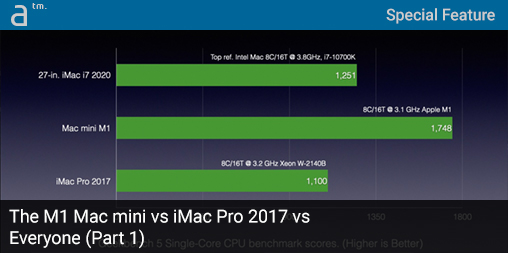Continued from page 1
GFXBench
This respected test suite is M1 native, giving us the ability to test M1’s graphics performance. We ran tests that could work on both Metal on the M1 and Metal on the iMac Pro. We looked at Driver Overhead, Texturing (fill rate), and ran the modern game-like Aztec Ruins test. In these tests, we offer various scores along with the two Macs and will explain why below.
GFXBench Aztec Ruins 1080 (normal tier)
This benchmark tests a modern graphics API across a game-like environment with real-time global illumination and deferred rendering combined with physically-based shaders. This test is highly applicable to not just games but “game-engine” based rendering tools. Some game engines support both forward rendering and deferred rendering paths, like Unity, which has partnered with Autodesk on many fronts, including its Revit application.

GFXBench Aztec Ruins, 1080p Test. Winner: M1 Mac mini defeats iMac Pro 2017. (Image: Architosh / All rights reserved.)
We can see above that today’s M1 is about 30 percent faster than the discreet AMD Radeon Pro Vega 56 graphics in the 2017 iMac Pro at this particular test. However, a top reference score from a machine with the NVIDIA GeForce GTX 1080 Ti is nearly 3x faster. That result had a DirectX 11 driver. The M1 faired much better against the same card tested with OpenGL. In that case, the discreet GPU’s performance fell to 1.8x faster. Interestingly, M1 is faster than an NVIDIA GeForce GTX 1050, approximately 1.5x times more rapid than this Pascal architecture-based discreet GPU from the fall of 2016.
Drive Overhead 1080 Test
There are many “draw calls” in this particular benchmark, which tests the summed up overhead of those calls to the CPU. The test shows how fast the software processes the various API calls. It’s an area where Apple controlling the whole stack should matter.

GFXBench Driver Overhead, 1080p Test. Winner: M1 Mac mini defeats iMac Pro 2017. (Image: Architosh / All rights reserved.)
The M1 in this test is faster than the minimum AMD GPU for running Enscape (i.e., AMD Radeon R9 270 but the M1 beat a faster R9 290X GPU). It is also faster than the iMac Pro’s AMD Vega 56 GPU, plus it tied an AMD Radeon D700 (score = 16,193) offered in the old 2013 iMac Pro. Recall, this D700 was essentially a modified AMD FirePro W9000 and was a beast in its day (2013), costing well over three thousand US dollars.
Texture Test
This benchmark approximates the texturing load of the Manhattan high-level test by rendering multiple layers of texture. It is a fill-rate test. As we can see from the chart below, this is the one test where the M1 falls behind the iMac Pro’s Vega 56 GPU. So in this test, we see how many pixels (texels) the GPU can render per second is approximately a little greater than half of what the Pro Vega 56 can do and a little less than half of what the Quadro 5000 card can do.

GFXBench Texture Fill Test. Winner: iMac Pro 2017 defeats M1 Mac mini. (Image: Architosh / All rights reserved.)
We can also see in the image below that the M1’s texel fill rate is similar to what the GeForce GTX 680 and AMD R9 280 can do. Both are discreet GPUs that exceed the lesser performing sibling GPUs specified by Enscape as “minimum requirements” for powering that professional real-time renderer used in the AEC industry.

GFXBench Texture Fill Test M1 results in comparable scores to other GPUs—most are discreet GPUs, including a few that set minimum GPUs for Enscape. (Image: Architosh / All rights reserved.)
The M1’s texel fill rate also exceeds that of the GPU performance in the NVIDIA Quadro P2000 (considered a baseline GPU for powering HTC Vive VR headsets). It also exceeds that of AMD Radeon Pro WX 9100 and the AMD D700 used in the 2013 Mac Pro.
Go to Part 2 — BaseMark, Speedometer 2.0, Real-World Tests and Conclusion




Reader Comments
Comments for this story are closed